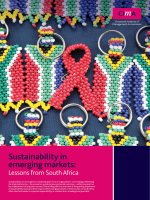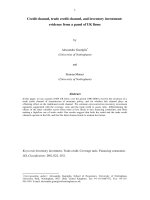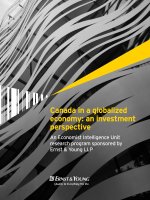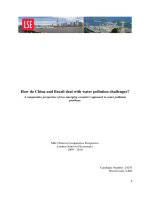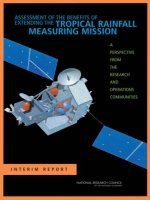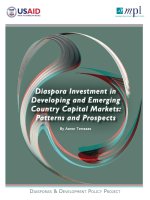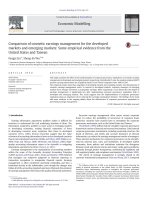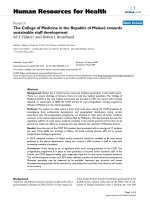Towards sustainable property investment perspective from asian emerging markets
Bạn đang xem bản rút gọn của tài liệu. Xem và tải ngay bản đầy đủ của tài liệu tại đây (1.54 MB, 129 trang )
TOWARDS SUSTAINABLE PROPERTY INVESTMENT: PERSPECTIVE FROM ASIAN EMERGING
MARKETS
LI ZHILIANG
NATIONAL UNIVERSITY OF SINGAPORE
2013
TOWARDS SUSTAINABLE PROPERTY INVESTMENT: PERSPECTIVE FROM ASIAN EMERGING
MARKETS
LI ZHILIANG
(BSc, SDJZU; MSc, Real Estate Finance, KTH)
A THESIS SUBMITTED
FOR THE DEGREE OF DOCTOR OF PHILOSOPHY
DEPARTMENT OF REAL ESTATE
NATIONAL UNIVERSITY OF SINGAPORE
2013
DECLARATION
I hereby declare that this thesis is my original work and it has been written by me in its entirety. I have duly
acknowledged all the sources of information which have been used in the thesis.
This thesis has also not been submitted for any degree in any university previously.
Candidate Name: LI ZHILIANG
Date: 26
th
September 2013
I
ACKNOWLEDGEMENT
I am deeply indebted to my thesis supervisor, Prof Deng Yongheng for his persistent guidance, patience and support
throughout my PhD study. Prof Deng is a well-established real estate economist and econometrician. Since the
beginning, I have been trained to come up with a research question and frame the research topic independently. It‘s
Prof Deng who inspires me on the topic of Asian sustainable property investment after working on the Singapore
green building economics project, and backs me at various occasions.
I am thankful for Prof John, M, Quigley, whose passing last year is a great loss to real estate academia. He is not only
a distinguished scholar, but also a good friend and mentor. I was honored to have worked with him on the Singapore
green building project, and impressed by his broad and profound knowledge and rigorous attitudes towards research. I
deeply mourn him, and hope my work could live up to his expectation. I also thank Prof Nils Kok for his inspiration
on the research topic. Besides, I am grateful to Prof Tu Yong, Prof Ong Seow Eng, Prof Sing Tien Foo, Prof Yu
Shiming, Prof Seah Kiat Ying, Prof Ooi Thian Leong, Joseph, Prof Fu Yuming, Prof Lee Naijia, and Prof Liao
Wenchi, for their dedications to my coursework teaching and valuable comments on my thesis. Meanwhile, I benefit a
lot from discussions with my classmates and friends, e.g., Yuan Xu, Zhang Huiming, Wu Jing, Li Pei, Radheshyam
Chamarajanagara Gopinath , Jiang Yuxi, and Omokolade Ayodeji Akinsomi. Also, I thank Zainab, Ko Chen, Li
Congmiao, Kevin, and Zheng Huiming for their administrative and logistic support.
Last but not the least, I thank my parents, parents-in-law, and friends in China, Singapore, and Sweden, who support
and encourage me to pursue the PhD degree along the way. In particular, I would never thank enough for my wife –
Sun Xiaocong (孙小丛), who has accompanied with me over the past decade. Any achievement I‘ve got so far, if any,
is not possible without her. Thus, this thesis is largely dedicated to her!
II
TABLE OF CONTENTS
Acknowledgement I
Summary V
List of Tables VII
List of Figures VII
Chapter One: Introduction 1
1.1Social Responsibility 1
1.2 Sustainable Property Investment 2
1.3 Research Background 3
1.4 State of The Art 5
1.5 Research Statement & Contribution 6
1.6 Organization of the Thesis 9
Chapter Two: The Greening of Asian Real Estate Industry 11
Abstract 11
2.1 Introduction 12
2.2 Literature Review on CSR 15
2.2.1 Opponents for CSR 15
2.2.2 Proponents for CSR 16
2.2.3 Capital Market Response to CSR 17
2.3 Institutional Difference in Asia 18
2.3.1 Green Certification System 19
2.3.2 Regulatory Instrument 20
2.3.3 Economic Instrument 21
2.4 Data Collection & Analysis 22
2.4.1 Environmental Data 22
2.4.2 Dependent Variable 25
2.4.3 Independent Variable 26
2.4.4 Descriptive Statistics 27
2.5 Empirical Analysis 28
2.5.1 Prior Empirical Studies on CSR-CFP Debate 28
2.5.2 Model Specification 30
2.5.3 Empirical Results 32
III
2.5.4 Robustness Test 32
2.6 Conclusion & Future Research 33
Chapter Three: Does It Pay To Go Green? Evidence from Singapore Housing Market 40
Abstract 40
3.1 Introduction 41
3.2 Literatures on Green Building Economics 43
3.3 The Singapore Green Mark Program & Certification 45
3.3.1 Application and Assessment Process 46
3.3.2 The Rating System 47
3.4 Data Collection & Description 47
3.5 Empirical Analysis 53
3.6 Conclusion 57
Chapter Four: The Financial Implication of Green Building Investment: Evidence From Singapore Property
Companies 68
Abstract 68
4.1 Introduction 69
4.2 Theoretical Argument 71
4.2.1 General Literatures on the CSR & CFP Association 71
4.2.1.1 Managerial Arguments 72
4.2.1.2 Finance Arguments 74
4.2.2 The Reverse Causality Issue 76
4.3 Underlying Environmental Policy 77
4.4 Data Collection & Description 80
4.4.1 Green Building Data 80
4.4.2 Green Building Investment of Property Companies 81
4.4.3 Financial Data 82
4.5 Empirical Analysis 83
4.5.1 Green Building Investment and Profitability 83
4.5.2 Green Building Investment and Firm Value 85
4.6 Robustness Test 87
4.7 Conclusion & Discussion 88
IV
Chapter Five: Conclusion & Discussion 100
5.1 Background 100
5.2 Summary of Major Findings & Implications 100
5.3 Limitations & Further Research 101
Bibliography 104
Appendices 113
V
SUMMARY
Despite the growing academic and industry interests in sustainable property investment, a good grasp of its market
performance is still void. As opposed to the West where the sustainable property investing practice was initiated, the
public awareness and academic research are sparse in Asia. Against this backdrop, this thesis seeks to provide the first
in-depth exploration of financial economic merits related to property investments based on environmental
sustainability principle in Asia.
The first essay is featured with a comparative analysis across some key Asian economies, e.g., China, Hong Kong, and
Singapore, to identify the ongoing best practices to promote sustainable property investment via certification system,
regulatory framework, and economic instruments. Importantly, Singapore is found to lead the region thanks to its
well-established environmental policy and market structure, and only in Singapore, property companies committing to
green building practice are significantly positively valued as opposed to other markets.
With the above finding and severe data limitation of other markets, the thesis proceed to exclusively focus on
Singapore, aiming to provide insightful implications to other Asian markets
1
. Presently, emerging literatures on green
building economics is greatly dominated by commercial sector in the western context. To enrich the literature body,
the second essay serves as the first study in Asia to examine the topic in Singapore housing market. Consistent with
existing studies, it documents a significant green price premium in Singapore private housing market.
Nonetheless, existing studies merely focus on higher market premium, leaving the net financial consequence of or
market return to sustainable property investment largely untapped. As such, the third essay intends to shed some light
on the net financial benefit by focusing on the financial performance of real estate operating companies (REOC) in
Singapore
2
committing to green building investment, with the hope to tackle the market hurdle of ―Vicious Circle of
1
Given its advanced economy, Singapore is hardly taken as ―Emerging‖ market. However, as far as the extent of the public awareness and
academic research of environmental sustainability is concerned, Asia as a whole lags behind the west. Thus, the term of ―Emerging Asian‖ in the
title is employed here to reflect the fact of the lagging but fast growing environmental sustainability in the region
2
Focus on real estate operating companies (REOCs) rather than real estate investment trust (REITs), mainly due to their inherent differences in
earnings distribution, corporate taxation, and more importantly the shunning of development activities of REITs in Singapore.
VI
Blame
3
. It argues that if developers who are first movers in green property are further rewarded, the projected wider
adoption of sustainable property practices would in turn enhance the awareness of demand side, eventually resulting in
the market norm of green real estate. It concludes a significant role of underlying environmental institution in
understanding the net financial result of sustainable property investment.
3
Simply speaking, it refers to that key market players blame each other for their hesitation to go green in a loop (Cadman, 2000)
VII
LIST OF TABLES
Table 2.1 Summary Statistics of Environmental Measures 36
Table 2.2 Summary Statistics of Major Variables 37
Table 2.3 IV Estimate Results of Regression on Environmental Sustainability 38
Table 2.4 IV Estimate Results of Cross-Country Environmental Sustainability Regression 39
Table 3.1 Characteristics of Private and Public Housing Markets in Singapore 59
Table 3.2 Comparison of GM and NGM-rated Dwelling Units 60
Table 3.3 PSM Regression Estimation of Unit Price on Dwelling Units Attributes 63
Table 3.4 Estimation of Project Fixed Effects 65
Table 4.1 Descriptive Statistics of Green & Financial Variables 93
Table 4.2 Correlation Matrix for Major Variables 94
Table 4.3 Pooled OLS Estimates on Sub-periods Analysis (Operating Performance) 95
Table 4.4 Pooled OLS Estimates on Sub-periods Analysis (Firm Value) 97
Table 4.5 Robustness Test of Alternative Estimation Approaches 99
LIST OF FIGURES
Figure 3.1 Annual Average Unit Price per square meter, 2000-2010 66
Figure 3.2 Green Fraction & Trading Volumes, 2005Q1-2010Q2 67
Figure 4.1 Green Mark Certified Properties in Singapore Developers‘ Portfolio 91
Figure 4.2 The Diffusion and Growth of Green Certified Properties 92
Introduction
1
CHAPTER ONE
INTRODUCTION
This PhD thesis bundles three empirical essays on the topic of sustainable property investment in Asia, aiming to help
understand the financial economic merits of environmental sustainability and the broader concept of corporate social
responsibility (CSR)
4
in real estate industry, from both investors and developers‘ perspective.
Although the CSR principles have been growingly integrated into property investment decision-making given the
rising awareness of climate change and resource scarcity among academia and practitioners, whether investing in
environmental sustainability and energy efficiency in real estate industry aligns with fiduciary responsibilities remains
largely unaddressed. Especially in Asia, public awareness of environmental sustainability and sophisticated academic
research still lag behind its counterparts in the West. Thus, this thesis seeks to provide the first in-depth research in
Asia of financial merits associated with different types of property investments based on environmental sustainability
principles, and ultimately contributes to the extant literatures of green building economics.
1.1 Social Responsibility
Spurred by anecdotal industrial revolutions since the 19
th
century, human society has evolved dramatically and
modern technology has continuously progressed. However, the material prosperity comes at the expense of the earth
ecosystem: it is not only being fatally damaged, but human activity has been leading to irreversible losses of critical
ecosystem functions, which together threaten the survival of human being. To address it, a new way to achieve
sustainable economic development without compromising the nature was called upon throughout the globe. Against
this backdrop, decades of efforts leads to the universally accepted principle of sustainability, i.e., ―development that
meets the needs of the present without compromising the ability of future generations to meet their own needs‖
4
It refers to that companies integrate social and environmental concerns in their business operations and in their interaction with their
stakeholders on a voluntary basis. (Renneboog et al., 2008).
Introduction
2
(Brundtland, 1987). The sustainability principle essentially balances between the anecdotal ―zero growth‖ argument
and others favoring the pure economic growth, seeking to harmonize the co-existence of the economy and the nature.
People integrated the principle into their business areas thereafter. The corporate social responsibility (CSR) and
socially responsible investing (SRI)
had become increasingly popular over the past decades, especially among
resource-intensive organizations, investors and companies dedicating themselves to primarily tackle the environmental,
social, and governance (ESG) issues. CSR, being a transparent business practice based on ethical values and respect
for all stakeholders, is designed to deliver sustainable value to society at large and impact on all business activities
including investment policies as well Notably, such investment policies can be grouped under the term of SRI
characterizing the behavior of investors, i.e., not only focus on economic gain but also follow ethical principles and
take into account environmental and social aspects
5
.
1.2 Sustainable Property Investment
The issue of social responsibility becomes appealing worldwide as ignoring environmental and/or social concerns by
investment decision-makers can be financially risky, which is particular the case for real estate industry. It shows that
the built environment is responsible for around 25-40% of total energy use globally, 30% of raw material use, 30-40%
of global greenhouse gas emissions, and 30 to 40% of solid waste generation (RICS, 20005). Also, people spend
almost 90% of their life inside buildings. Thus, this industry significantly matters to human health and well-being
(OECD, 2003 and UNEP, 2006). Furthermore, the shifting consumer behavior, tightened building mandate,
increasingly expensive material inputs and scarce resource, and greater pressure from stakeholders all converge to
make it both financially risky to ignore and financially beneficial to address the ESG issues in the process of real
5
Such investors either avoid investments into particular companies and products or they systematically select and support other companies and
products through their investment.
Introduction
3
estate investing. Hence, the contribution of property sector to sustainable development is immense
6
, and the potential
of the built environment to mitigate its related negative externality is substantial.
The notion of sustainability and social responsibility has already emerged on property investment agendas. The past
decades has witnessed a growth of similar concepts, e.g., responsible, and sustainable property investing. Specifically,
both encompass the goal of maximizing positive and minimizing negative effects of property investment on society
and the natural environment (Pivo and McNamara, 2005), but the former (responsible) allows for an investment
strategy to be considered responsible even if the maximization of positive effects and the minimization of negative
effects take place within the tight boundaries set by financially-oriented and short-term investor goals, while the latter
(sustainable) goes one significant step further since the investor lays down appropriate conditions so that all his (or her)
actions are aimed at being sustainable. For the sake of brevity and consistency, sustainable property investment will be
the lead terms in this thesis, which is defined as the property investment in pursuit of sustainability, as well as the
well-being and economic benefit measured in terms of financial, natural and social capital (e.g., Lorenz et al., 2008).
1.3 Research Background
Amidst the global proliferation of green building rating systems
7
assessing buildings‘ environmental and energy
performance, environmental sustainability and energy efficiency are giving rise to the green transformation of the real
estate industry, from which investors can benefit from investing in the sustainable property assets. Meanwhile, the
improved availability and transparency of sustainable (green) property data makes it possible to conduct empirical
research in Asia where academic research has been long sparse.
6
The contribution of products and services to sustainable development is usually described and evaluated by an assessment of both their ability
to meet current and future requirements as well as their capability of keeping current and future impacts, expenses and risks within certain limits
or boundaries. If the assessment results are positive, such products and services are commonly called ‗sustainable‘. This also applies for
buildings and constructed works (Lorenz et al., 2008). Buildings and the investments in buildings have the potential to contribute to sustainable
development (Lützkendorf and Lorenz, 2005). For the purpose of this paper, the terms ‗sustainable building‘ and ‗sustainable property
investment‘ are used for simplicity instead of the term ‗buildings and investments that contribute to sustainable development in this paper.
7
The term sustainable building is usually used interchangeably with green building, whose purpose is to reduce the adverse human impacts on
the natural environment, while improving our quality of life and economic well-being (Ministry for the Environment , New Zealand, 2005)
Introduction
4
It is crucial, however, to recognize that the mainstreaming of sustainable property investment is still deterred by the
―Vicious Circle of Blame‖ (Cadman, 2000), i.e., the misalignment between supply and demand for occupation and
investment in sustainable property assets. For example, developers complain about the lack of demand for green space,
and concurrently environmentally conscious occupiers can barely find green space at all.
Arguably, the circle can be broken up by providing market participants with hard evidence on both the improved
environmental performance of buildings, and more importantly its superior financial performance. Also suggested by
the classic economic assumption of ―rational agent‖, one should invest in sustainable property not only because this is
the good thing to do, but a good investment deal. Ultimately, increasing economic return, sustaining the natural
environment and protecting social values are not incompatible. Therefore, the market barrier can be tackled by
offering both business cases for companies and investment cases for investors that it pays to be green.
Regardless of recent public and private initiatives to promote sustainable property investment, the signals from
marketplace remain obscure, as developers and investors are understandably uncertain about how far to go in investing
in real estate sustainably due to the lack of sufficient evidence of financial benefits (Eichholtz et al., 2010). While
sustainable investing practices in Asia still lag behind the west, it is attracting more and more interest.
Essentially, several stylized facts can justify the necessity of conducting such a research in Asian property market:
Firstly, the fast economic growth is always accompanied with the severe negative environmental impact. Projected
trends in urbanization put much pressure on urban capacity, leading to considerable infrastructure projects that will
have implications for resource consumption. If China‘s per capita greenhouse gas emissions rose to U.S. levels, then
global carbon emissions would increase by more than 50 %. Besides, according to the World Health Organization
(WHO) estimates, two-thirds of diseases attributable to air pollution worldwide occur in emerging Asia which is
particularly vulnerable to rising temperatures and sea levels, and the physical risks of climate change.
Introduction
5
Secondly, in the western society, civilians have pressured companies and regulators towards sustainability initiatives
in the ‗bottom-up‘ approach. In contrast, civil society activity is limited in Asia, and sustainability movement is
mostly promoted by public sector in the ‗top-down‘ approach; Thirdly, there are several unique governance issues in
Asian capital market which may contribute to the low acceptance and performance of CSR strategy, such as the lack
of transparency, limited regulation/enforcement, and concentrated shareholder structures and family ownership.
1.4 State of The Art
The debate of CSR and its impact on corporate financial performance (CFP) has been long studied in management
science and financial economics domain, whilst it is under-researched in real estate area. As CSR is a
multi-disciplinary concept (Carroll, 1979), different disciplines can be employed and also different perceptions can be
anticipated. Scholars and practitioners in real estate industry have recently borrowed from other disciplines to justify
the greening of real estate industry. For instance, using the conceptual corporate environmental responsiveness
framework (Bansal and Roth, 2000) with a real estate dimension added, Eichholtz, Kok and Quigley (2011b)
systematically analyze why companies occupy green office space in the U.S.
Two competing theoretical arguments dominate: on the one hand, those criticizing CSR rely on the neoclassical
microeconomics that the costs associated with CSR improvement are likely to outweigh the financial benefits, which
is as opposed to the underlying principle of shareholder wealth maximization (e.g., Friedman, 1962). Understandably,
environmental activities involve much of corporate resources, but the potential benefits of such measures could be in
the distant future, if any. Thus, it argues that there is no role for CSR and that firms should only care about their
shareholders‘ profit (Friedman, 1962). Indeed, real estate investors used to hold that social or environmental issues
should be taken care of by government and not of direct concern to their investment practices.
On the other hand, advocates for CSR may also be rooted in the neoclassical microeconomics in that CSR may help
address the agency problems and the external costs. Heal (2005) finds that the government does not fully resolve all
Introduction
6
problems with external effects. In this regard, CSR activities can substitute missing markets and reduce conflicts of
interest among stakeholders. Also, both the stakeholder theory and resource-based view of firm favor meeting all
stakeholders‘ expectations, rather than only shareholders‘, by engaging CSR activities. Throughout the thesis, it is in
support of the argument of the positive association between CSR, or more specifically environmental sustainability in
real estate industry, and financial performance both at property asset market and public market.
In terms of real estate-related CSR aspects, environmental sustainability appears the major focus, whereas less
emphasis is placed on social and community concern. In addition, anecdotal CSR literatures can be well applied to its
subsets, i.e., particularly corporate environmental performance (CEP) in this thesis.
1.5 Research Statement & Contribution
Several features underpin the contributions of this PhD thesis. To begin with, I provide the first cross-country analysis
in Asia in Chapter 2 to identify the currently best practices to direct the built environment towards environmental
sustainability, and explore whether and how sustainable property investment is valued. Although the concept stems
from the West, it is an open question whether or not the reported evidence of financial benefits of sustainable property
investment is sample-specific and subject to the underlying environmental institution. I attempt to address these issues
in Asia where the uniqueness of institutional set-up, cultural background, and market structure allow governments in
the region to promote sustainable property investment via a top-down approach.
Given the data richness, employing two types of environmental sustainability measurements sheds some light on the
appropriateness of the environmental screening for sustainable property investment. To mitigate the reverse causality
issue, the ―Instrumental Variable‖ (IV) regression is applied to the empirical analysis. It documents an initial evidence
of a positive relation between environmental performance and firm value. More importantly, it suggests that the extent
to which individual market values the environmental sustainability of real estate is significantly different, depending
on both the underlying environmental policy and market structure. Essentially, only in Singapore where underlying
Introduction
7
environmental institution is well established and strictly implemented, property companies with superior
environmental performance enjoys higher market value than its counterparts.
The aforementioned dependency of CEP-CFP relation in Asian real estate industry on the market structure and
environmental policy warrants further studies at market level. Due to the severe data scarcity in other markets, the
thesis proceeds to exclusively center on the financial consequence of investing in environmental sustainability in
Singapore real estate. In line with the conventional property investment, sustainable property investment may take
several forms
8
: Ones could invest in individual or a portfolio of properties certified as environmental sustainably by
the globally proliferated green building rating schemes, e.g., Energy Star, Green Mark; or they may invest in publicly
traded real estate companies making environmental sustainability a key part of their corporate strategy.
Chapter 3 and Chapter 4 subsequently contribute to a detailed investigation on the economic pay-off of sustainable
property investment in Singapore at asset market and capital market, respectively. Previous literatures on the financial
performance of sustainable properties are either from engineering perspective, being an ex ante predictions for policy
implementation (Jacobsen and Kotchen, 2009). With the improved data availability, empirical studies have recently
reported the alignment between better environmental and energy efficiency performance and improved financial gains
for both new and existing properties. For example, Eichholtz et al., (2010), Fuerst and MacAllister (2011a and
2011b), and Kok, Miller and Morris (2012) report significant green premiums associated sale price and rent for the
U.S. office market. Brounen and Kok (2011) find that consumers seem to capitalize the energy information into house
prices in Dutch residential market. Further, the energy labels command significant higher rents and selling price to
certified office buildings in Dutch as well (Kok and Jennen, 2011).
However, few systematic analyses on the ―green price premium‖ in the housing market have been performed,
especially in Asia. Hence, I fill out this gap by assessing the private return of sustainable dwelling units in Singapore,
namely, whether or not the green certified dwelling units in multifamily housing projects yield higher asset values
8
There are other real estate investment forms as well. However, given the data limitation and research objectives of the thesis, the
aforementioned two types of sustainable property investments are of primary interest and are believed to be most relevant to Asian market
players.
Introduction
8
than non-green ones (Chapter 3). The ―Green Mark‖ rating system launched in 2005 makes Singapore a unique
test-bed to provide an Asian insight into green building‘s financial performance at asset market. The propensity score
matching (PSM) approach is employed to reduce any influencing impact of housing attributes. With some matched
37,000 transactions in the Singapore private housing market during 2000 and 2010, it analyzes the private returns to
green building investments by evaluating the premium in asset values they command in the marketplace. Estimate
results show that the green price premium relative to conventional dwelling units is significant even controlling for the
broadest number of hedonic characteristics. Remarkably, this is one of the first analyses of the economics of green
building in the residential sector. The results may provide insight about the operation of the housing market in one
country, but the policy implications about the economic returns to sustainable investments in the property market can
have broader applications for markets in emerging Asia.
Despite the emerging evidence of financial benefits of sustainable property investment at asset market, the market
adoption of sustainable property remains sluggish. Plausibly, it may be attributed to several reasons: (1) the ―Vicious
Circle of Blame‖ featured by the misaligned response between demand and supply side of sustainable property market.
Eichholtz et al (2011b) apply a conceptual management model with the real estate dimension to explore the green
office rental decision. Importantly, it suggests that corporate tenants may occupy green space for the competitive
advantage, legitimation or environmental responsibility, depending on the nature of individual industry. Yet, their
study is only focused on the demand side of property market, without reference to supply side. Also, some contextual
dimension of the association between corporate incentives and environmental strategy, e.g., capital market‘s scrutiny,
is ignored; (2) anecdotal studies just consider the benefits without costs of sustainable property investment, leading to
no convinced cost-benefit conclusion
9
and thus the uncertainty of the net financial performance of such investments.
As the financial performance of property companies that are directly involved in property development and investment
is the eventual consequence of the interplay between the cost and benefits of green buildings, examining this interplay
can shed some light on the net financial consequence of investment in sustainable properties. Also, it believes that if
property companies are further rewarded, the projected wider adoption of sustainable property practices would in turn
9
Except for some pilot projects and case studies that yield inconclusive results on the net benefits.
Introduction
9
enhance the awareness of demand side, eventually resulting in the market norm of green real estate. Against this
background, an exploration of the association between property companies‘ financial performance and their
environmental performance in Chapter 4 both sheds some light on the net benefits of going green and contributes to
the full picture of market responsiveness of the greening of real estate industry.
Besides, the fact that the minimum environmental sustainability performance has been mandated in Singapore as of
2008 enables a further investigation of the important role of environmental institution in understanding the financial
consequence of environmental sustainability in real estate investment industry. A dynamic dataset of green property
portfolios of all public property companies is Singapore are developed. Empirically, sub-period analysis is robust to
alternative estimation method and concludes that only under stringent environmental policy regime do property
companies committing to sustainable property practice in Singapore outperform the market peers.
Taken as a whole, the three empirical essays systematically examine economics of (direct and indirect) sustainable
property investment in Asia, thus aiming to convince the market participants of the financial benefits of the greening
of real estate industry. Empirical results may be not only informative to real estate markets‘ practitioners keen to
integrate environmental information into corporate strategies and investment criteria, but the policy implications about
the economic pay-off to sustainable property investments can have broader application for markets in emerging Asia,
in which the sparkling economic growth is accompanied with the severe environmental deterioration, fast-growing
urbanization, the ‗top-down‘ approach to promote sustainability, and the concentrated shareholder / family ownership
capital structure (Zheng et al., 2009; Cheung et al., 2010).
1.6 Organization of the Thesis
This thesis is organized as follows. Chapter Two presents the first essay, titled ―The Greening of Asian Real Estate
Industry‖ It examines the emerging market recognition of environmental sustainability in Asian real estate investment
industry. The economic price premium of investing in energy efficiency and sustainability in housing markets in
Singapore is investigated in Chapter Three, titled ―Does It Pay To Go Green? Evidence from Singapore Housing
Introduction
10
Market”. Chapter Four presents the third essay, titled ―The Financial Implication of Green Building Investment:
Evidence from Singapore Property Companies”. This chapter explores the financial consequence of property
companies in Singapore committing to environmental sustainability, moderated by the dynamic underlying
environmental policy. The final chapter concludes the thesis, highlights the limitations of the study, as well as offer
recommendations for further research.
The Greening of Asian Real Estate Industry
11
CHAPTER TWO
THE GREENING OF ASIAN REAL ESTATE INDUSTRY
*
ABSTRACT
Although it is growingly recognized that the greenness of real estate industry has great potential to tackle the climate
change issue, academic research and public awareness in Asia has lagged behind its counterpart in the west, due
largely to the data constraint. Against this backdrop, this essay seeks to conduct the first Asia-focused comparative
analysis to identify the best practices to direct the built environment towards environmental sustainability, as well as
initially evaluate how environmental sustainability in real estate is valued financially. Tobin‘s Q is used to measure the
intangible asset of firm value, while the use of two types of environmental performance proxies can shed light on the
appropriateness of environmental screening for sustainable property investment. Empirically, the ―Instrumental
Variable‖ (IV) regression is employed to in part alleviate the reverse causality issue.
This essay concludes Singapore as the regional leader in greening its built environment via a good combination of
environmental institution and market structure. Importantly, it documents that whether or not environmental
sustainability in real estate is valued relies on the underlying institutional frameworks and market structure in the
sense that only in Singapore, property companies committing to green buildings enjoy a higher value, as opposed to
other markets. Implications can be substantial to other emerging Asian economies eager to promote environmental
sustainability in the built environment.
*
This chapter is a modified version of ―Towards sustainable property investment: Evidence from Asia‖ by Zhiliang Li and Yongheng Deng,
which was initially presented at the symposium of Harvard Kennedy School titled ―The Societal Function of Investment Asset Class: Implication
for Responsible Investment‖, Oct 2012, Cambridge.
The Greening of Asian Real Estate Industry
12
2.1 Introduction
Environmental sustainability
10
has become the central theme of corporate social responsibility (CSR) nowadays, not
only reflecting the public concern about climate change but also the shifting taste amongst consumers and investors
(Stern, 2008). In particular, institutional investors with real estate exposure are facing broad societal pressure to assess
and improve the environmental performance of their real estate investments (Bauer et al., 2011). Accordingly, the
extent that real estate entities incorporate environmental sustainability into their business strategy now becomes a
matter of great interest to market participants.
To meet the non-financial information needs of investors, several private and public initiatives have been shaped, e.g.,
the Carbon Disclosure Project (CDP) and the United Nations Global Compact (UNGC). Also, public entities are eager
to exhibit their environmental awareness and responsible activities through CSR reporting, engaging third-party CSR
rating, or the inclusion into sustainability indices, and so forth
11
.
What is more relevant to the real estate industry is the global emergence of green building rating systems
12
, being a
critical step towards promoting investment in sustainable real estate and private provision of environmental public
goods (Kotchen, 2006). Properties certified as ‗green‘ are not only marketed as having better energy and
environmental performance, but also aligned with significant market premium (e.g., Eichholt, Kok and Quigley, 2010
and 2011a; Fuerst and MacAllister, 2011a and 2011b; Brounen and Kok, 2011; Kok and Jennen, 2011; and Deng, Li
and Quigley, 2012). It will also help publicize property companies‘ strong commitment to environmental sustainability
stewardship (Eichholtz et al., 2010).
Nonetheless, the mainstreaming of sustainable property investment is still stagnant. Some attribute it to the lack of
sufficient information on the financial performance (Pivo, 2008). Indeed, there has been so far no publicly available
10
Since the Brundlandt report in 1987, environmental sustainability has been widely accepted as development that meets the needs of the present
without compromising the ability of future generations to meet their own needs.
11
For example, KLD, SAM and Innovest are independent third-party CSR or sustainability rating agencies; Dow Jones Sustainability index,
Domini 400 Social index, and FTSE KLD 400 Social index.
12
LEED and Energy Star in the U.S., BREEAM in the U.K., Green Mark in Singapore, Green Star in Australia, and HKBEAM in Hong Kong
The Greening of Asian Real Estate Industry
13
evidence on the financial consequences of committing to environmental sustainability at firm level, leading investors
and property owners largely reluctant to allocate more green property into their investment portfolio. Against this
background, this paper aims to fill this gap by examining whether or not, and to what extent does corporate
environmental performance (CEP) relate to corporate financial performance (CFP) in the real estate industry.
There is abundance of literature on the CSR/CEP-CFP debate. One intriguing question has been the source of this
controversy - can firms‘ environmental performance be aligned with the added-value? On the one hand, skeptics
perceive that CSR is too expensive to comply with the shareholder value-maximization principles (Friedman, 1962;
Henderson, 2002); on the other hand, CSR has been increasingly embraced within the business community due to its
perceived tangible and intangible benefits (e.g., Shrivastava, 1995; Turban and Greening, 1996). Several decades‘
research has yielded mixed results, mainly attributed to the measurement problem of environmental screening
(Waddock et al., 1997), methodological inconsistencies (Ulman, 1985; Griffin et al., 1997), or endogenity issues (e.g.,
Nogareda et al., 2006). This paper extends the existing literature and provides evidence that there is a positive
relationship between firms‘ environmental and financial performance in the real estate industry, and the association
depends on the underlying environmental policy and market structure.
Given the intangible nature of CSR-related benefits (Turban and Greening, 1996), Tobin‘s Q, measuring market
expectation of future profitability, is used to measure firm valuation. Arguably, it is adequate to reflect the intangible
reputation effect, investor trust, and investor risk
13
(e.g., Guenster et al., 2011; Dowell et al., 2000; Konar and Cohen,
2001). Empirically, I employed two sets of environmental sustainability proxies: (1) the environmental dimension of
―Asian Sustainability Rating‖ score, which is a disclosure-based proxy developed by the ―Responsible Research‖; (2)
the binary variable indicating concrete green property commitments of real estate firms. The empirical results of this
study can shed light on the appropriateness of the environmental screening for sustainable real estate investment
14
.
13
Plausibly, using this variable may avoid the bias of manipulation of some accounting-based variables.
14
Pivo (2005) pointed out that one screening process is needed for investors to determine whether director indirect sustainable property
investment products meet their needs. He suggests that in the real estate industry, green building certification is more appropriate than the
conventional social screening. As such, by using the two types of environmental screening approach this study allows us to identify which type is
materially applicable to the context of sustainable real estate investment.
The Greening of Asian Real Estate Industry
14
To address the potential endogenity problem and omitted variable bias, an instrument variable (IV) approach is
employed to examine the CEP-CFP link in the sample countries from 2010 to 2011. Notably, Asian economies are at
different stages of economic development and thus have different levels of environmental awareness. The uniqueness
of institutional and cultural background allows some governments among these Asian economies to promote
sustainable real estate investment via a top-down approach. Such unique institutional variations allow us to test
whether the debated CEP-CFP relation may vary across markets, depending on the underlying institutional
frameworks to encourage environmental sustainability in the built environment.
A positive association between real estate companies‘ environmental performance and firm valuation is reported,
though marginally. It documents the firm value differential across markets, subject to both environmental set-up and
market structure. Essentially, only in Singapore where underlying environmental institution is well developed and
strictly implemented, a real estate company committing to green building practices enjoys higher market value.
Moreover, results are in favor of green building practice as the environmental screening measure for future research
given its visibility to the market.
Implication can be substantial to multiple parties: it will ease corporate managers‘ concern to go green without
compromising financial objectives, which is consistent with the existing literature (e.g., King and Lenox, 2002); For
those interested in sustainable real estate investment in Asia, results suggest investing where a proper combination of
stringent environmental policy and incentive program has been well established and rigorously implemented; Lastly, it
will give rise to the policy instrument to guide the built environment towards environmental sustainability.
The rest of the paper proceeds as follows: Section 2 conducts a literature review on CSR and its effect on CFP;
Section 3 discusses institutional difference; Data collection and analysis are presented in Section 4, followed by the
empirical analysis in Section 5; Section 6 concludes and discusses some limitations and further research.
The Greening of Asian Real Estate Industry
15
2.2 Literature Review on CSR
In recent years, CSR and its subsets, e.g., CEP in this study, have become societal focus that requires the business
community to take on responsibility towards environmental, social and government issues in general (Orlizky, 2001).
Among different perspectives of CSR, McWilliams and Siegel (2001), for example, defines it as actions furthering
social good beyond the interest of the firm and what is required by law. Others (e.g., Heal, 2005) consider CSR as
being able to avoid social distributional conflicts and thus reduce the externality. Notably, there has been a wide divide
in the theoretical argument on the CSR-CFP debate (Griffin and Mahon, 1997).
2.2.1 Opponents for CSR
Above all, those criticizing CSR rely on the neoclassical microeconomics that the costs associated with CSR
improvement are likely to outweigh the financial benefits, which is inconsistent with the underlying principle of
shareholder wealth maximization (e.g., Friedman, 1962 and 1970; Telle, 2006). Understandably, environmental
activities involve much of corporate financial resources, but the potential benefits of such measures are mostly in the
distant future, if any (e.g., Henderson, 2002; Walley and Whitehead, 1994). Thus, it argues that there is no role for
CSR and that firms should only care about their shareholders‘ profit (Friedman, 1962). Further, McWilliams et al.,
(2006) and McWilliams & Siegel (2001) report that the overall effect of CSR is neutral in equilibrium.
The criticisms of CSR may also be rooted in the arguments of stakeholder theory and corporate governance.
According to Freeman (1984), managers need to balance the interests of all stakeholders, rather than shareholders‘
interests only, to the extent that the aggregate welfare is maximized (Renneboog et al. 2008). And yet, it fails to
address the problem of how to aggregate welfare and how to make the tradeoff amongst stakeholders. Also, in a
competitive market, firms pursuing social or environmental objectives by lowering their economic profits may not
survive the competition (e.g., Renneboog et al., 2008; Baumol, 1991). Shleifer (2004) even argues that competitive
pressure from markets, to some extent, encourages unethical corporate behavior.
